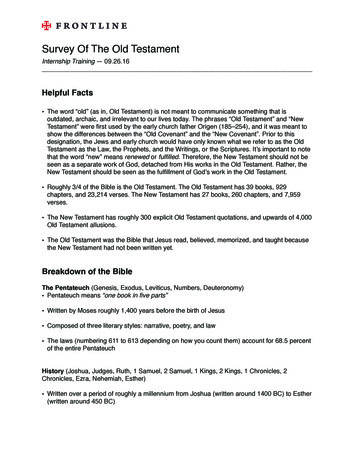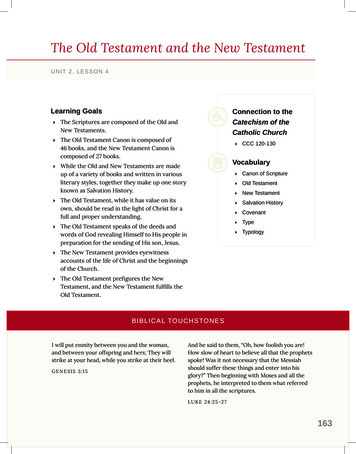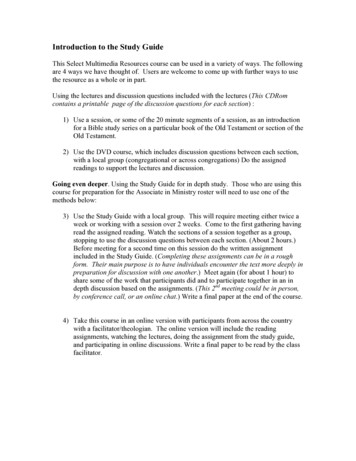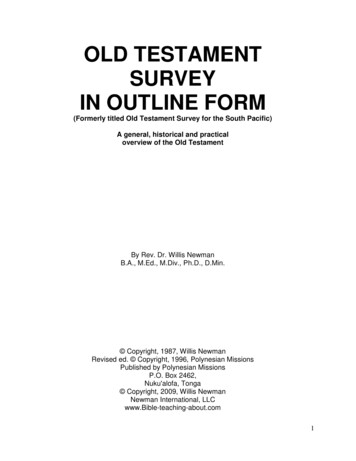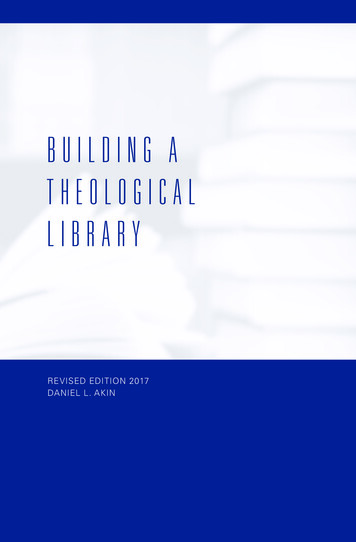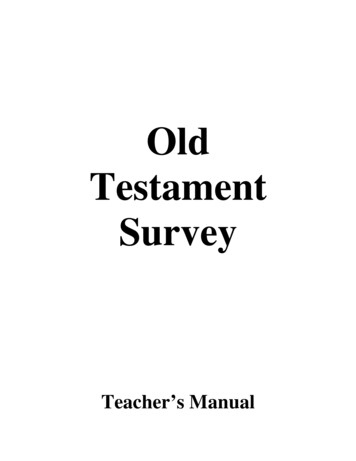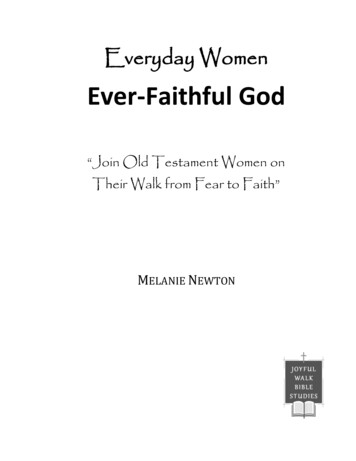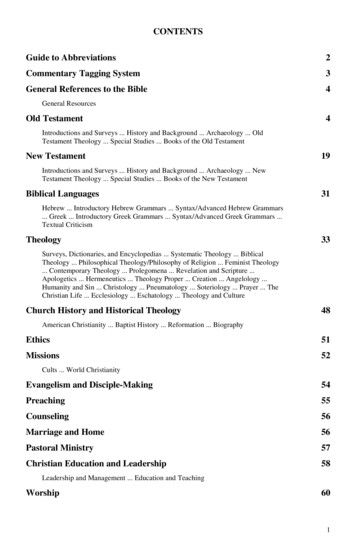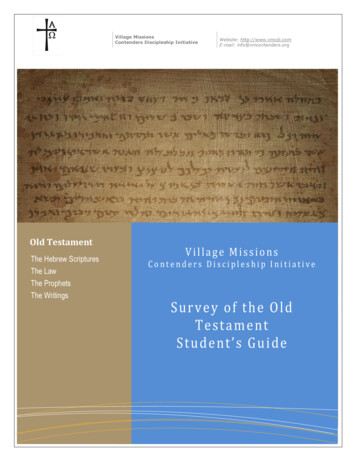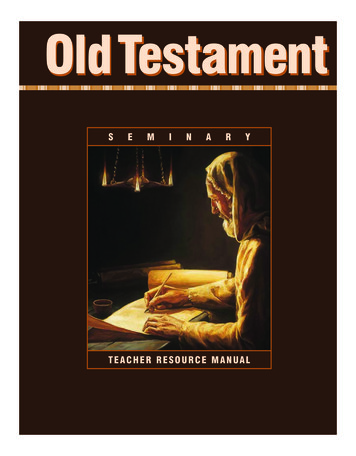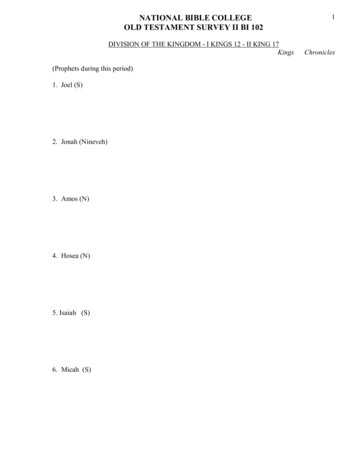
Transcription
NATIONAL BIBLE COLLEGEOLD TESTAMENT SURVEY II BI 102DIVISION OF THE KINGDOM - I KINGS 12 - II KING 17Kings(Prophets during this period)1. Joel (S)2. Jonah (Nineveh)3. Amos (N)4. Hosea (N)5. Isaiah (S)6. Micah (S)1Chronicles
2NATIONAL BIBLE COLLEGEOLD TESTAMENT SURVEY II BI 102KingsIII. REHOBOAM (1) OF JUDAH ANDJEROBOAM (1) OF ISRAELA. The folly of RehoboamChronicles1K 12:1-14:31 2C 12:11K 12:1-24B. Kingdom divided: Jeroboam becomes king of Israel (North) 1K 12:25-33 2C 10:12-19C. Prophecy against Jeroboam’s false altars1K 13: 1-10
JUDAH: THE CONTINUING DAVIDIC DYNASTY IN THE SOUTHI. First religious decline and revival - about 86 yearsKING1. Rehobaom931 B.C.2. Abijam(Abijah)3. Asa4. JehoshaphatLENGTHOFREIGN1734125SOURCEI Ki. 12, 142 Chron. 10-12I Ki. 152 Chron. 13I Ki. 152 Chron. 14-162 Ki. 222 Chron. 17-21GOOD OREVILEPROPHETS(Writing ahaziel,MicaiahISRAELITEKINGFOREIGNPOWERSI1. Jeroboam IJeroboam IShishak's invasion, Jerusalemraided2. Nadab,II3. Baasha,4. Elah,5. Zimri,III6. Omri7. Ahab8. Ahaziah9. JehoramWar with Zerah.Asa buys aid of Benhadadagainst Baasha,Fights with Ahab against SyriaAmmon & Moab come againstJudah.Fights with Jehoram againstMoab-Mesha
II. Second decline and revival - about 207 yearsKING5. Jehoram(benJehoshaphat)6. Ahaziah(ben Jehoram)(Athaliah)7. Joash(Jehoash)(ben Ahaziah)8. AmaziahLENGTHOFREIGN8SOURCEGOOD OREVIL2 Ki. 82 Chron. 21E12 Ki. 8, 92 Chron. 22E402 Ki. 11, 122 Chron. 23,24E292 Ki. 142 Chron. 252 Ki. 14, 152 Chron. 26G9. Uzziah(Azariah)5210. Jotham1611. Ahas1612. Hezekiah29PROPHETS(Writing ramZechariahben Jehoiaha,Joel?IsaiahG?Isaiah,Micah2 Ki. 152 Chron. 272 Ki. 162 Chron. 28GIsaiahMicahIsaiahMicah2 Ki. 18, 212 Chron. 29, 33G?EISRAELITEKINGIsaiahIV10. Jehu,11. Johahaz12. Joash13. Jeroboam II14. Zechariah15. ShallumV16. Menahen17. PekahiahVI18. PekahPekahPekahVII19. HosheaHosheaFall of Samaria721 B.C.Hazael against Gath andJerusalem.Joash buys him off.Successful Ammonite WarInvasion of Resin of Syria andPekah of Israel.Ahaz sends tribute to TiglathPileser, who relievesJerusalem.Sennacherib invades Judah,smitten by angel of Jehovah.Hezekiah receives embassyfrom Merodach-Baladan
III. Third decline and revival - about 88 yearsKING13. ManassehLENGTHOFREIGN5214. Amon215. Josiah31SOURCEGOOD OREVIL2 Ki. 212 Chron. 332 Ki. 212 Chron. 332 Ki. 22,232 Chron. 33,34E16. Jehoahaz(Shallum)17. sseh carried to Babylon; later returned;tribute to Esarhaddon and Assurbanipal.EGIV.KINGPROPHETS(Writing HabakkukJosiah killed while opposing Pharaoh Necho atMegiddo.Final decline - about 23 yearsGOOD OREVILPROPHETS(Writing prophetsunderscored)Jeremiah2 Kings 232 Chron. 362 Kings 232 Chron. 36EEJeremiahUrijah18. Jehoiachin(Coniah,Jeconiah)1/42 Kings 242 Chron. 36EJeremiah19. Zedekiah112 Kings 24, 252 Chron. 36EJeremiah,Obadiah?FOREIGNPOWERSDeposed and carried to Egypt by NechoPlaced on throne by Necho, paid tribute to Egypt.Later, Nebuchadnezzar came up against Jerusalem,took Daniel, 3 friends, a few other hostages toBabylon-605 B.C. Jehoiakim then rebels, is boundby Nebuchadnezzar, but was killed by his ownnation.Babylonians besiege, capture Jerusalem.Jehoiachin, Ezekiel, many other people of positioncarried to Babylon, 597 B.C. Zedekiah rebelsagainst Babylon, Nenuchadnezzar besieges, takesJerusalem, destroys city and temple, takesZedekiah and many people captive to Babylon, 586B.C.
3NATIONAL BIBLE COLLEGEOLD TESTAMENT SURVEY II BI 102KingsD. The man of God disobeys1K 13:11-34E. Nadab (2) succeeds Jeroboam (of Israel)1K 14:1-20F. Judah apostatized under Rehoboam1K 14:21-30G. Rehoboam dies1K 14:31IV. ABIJAM (2) AND ASA (3) (OF JUDAH)1K 15: 1-24A. Abijam1K 15:1-7B. AsaChronicles2C 12:12C 12:13-162C 13:22-14:1a1K 15:9-242C 14:1b-8
NATIONAL BIBLE COLLEGEOLD TESTAMENT SURVEY II BI 102KingsA. NadabChroniclesno record of northernkings except as theyrelate to Judah.1K 15:25-27B. Baasha (3)1K 15:27-16:6C. Elah (4)1K 16:6-10D. Zimri (5)1K 16:10-20E. Omri (6)1K 16:21-28V. NADAB TO OMRI (OF ISRAEL)4
5NATIONAL BIBLE COLLEGEOLD TESTAMENT SURVEY II BI 102KingsVI. AHAB (7) AND ELIJAH (ISRAEL)1K 16:29-22:40A. The man Ahab1K 16:28-34B. The man Elijah1K 17:1-19:211. God’s provision1K 17:1-242. Elijah’s challenge1K 18:1-403. Elijah’s lapse1K18:41-19:3Chronicles
6NATIONAL BIBLE COLLEGEOLD TESTAMENT SURVEY II BI 102Kings4. Elijah’s encouragementC. Ahab’s military exploitsVII.JEHOSHOPHAT (4) (OF JUDAH)VIII. INTRODUCTION TO AHAZIAH (8) OF ISRAEL(son of Ahab)Chronicles1K 19:4-211K 20:1-22:401K 22:41-50 2C 17-201K 22:51-53 2C 20:35-21:1
7NATIONAL BIBLE COLLEGEOLD TESTAMENT SURVEY II BI 102KingsChroniclesIX. AHAZIAH (8) OF ISRAEL TO THE ASSYRIAN CAPTIVITY 2K 1:1-17:41A. The reign of Ahaziah (8) of Israel2K 1B. The reign of Jehoram (9) of Israel2K 2:1-8:151. The translation of Elijah2K 2:1-112. The beginning of Elisha’s ministry2K 2:12:25KingsChronicles
NATIONAL BIBLE COLLEGEOLD TESTAMENT SURVEY II BI 1023. Jehoram’s battle with Moab2K 3:1-274. Elisha’s ministry2K 4:1-8:15a. Elisha and the widow2K 4:1-7b. Elisha and the Shunamite woman2K 4:8-378
9NATIONAL BIBLE COLLEGEOLD TESTAMENT SURVEY II BI 102Kingsc. Elisha and the poison pot2K 4:38-41d. Elisha and Naaman the Leper2K 5:1-27e. Elisha and the ax head2K 6:1-7Chronicles
10NATIONAL BIBLE COLLEGEOLD TESTAMENT SURVEY II BI 102Kingsf. Elisha and King of Syria (Aram)2K 6:8-8:6g. Elisha in Damascus2K 8:7-15C. The reign of Jehoram (5) of Judah2K8: 16-24Chronicles2C21: 1-20
11NATIONAL BIBLE COLLEGEOLD TESTAMENT SURVEY II BI 102KingsChroniclesD. The reign of Ahaziah (6) of Judah2K8: 25-292C22: 1-9E. The reign of Jehu (10) of Israel2K 9:1-10:361. Jehu anointed by Elisha2K 9:1-102. Jehu defeats Jehoram of Israel2K 9:11-10:17
12NATIONAL BIBLE COLLEGEOLD TESTAMENT SURVEY II BI 102Kings3. Jehu destroys Baal worshipersChronicles2 K 10:18-36F. The reign of Athaliah of Judah2 K11:1-162C 22:10-23:15G. The reign of Jehoash (Joash) (7) of Judah2 K11:17-12:21 2 C23:16-24:27
13NATIONAL BIBLE COLLEGEOLD TESTAMENT SURVEY II BI 102KingsH. The reign of Jehoahaz (11) of Israel2 K13:1-9I. The reign of Jehoash (Joash) (12) of Israel2 K13:10-25J. The reign of Amaziah (8) of Judah2 K14:1-22Chronicles2 C25:1-28
14NATIONAL BIBLE COLLEGEOLD TESTAMENT SURVEY II BI 102KingsK. The reign of Jeroboam II (13) of Israel2 K14:23-29L. The reign of Azariah (Uzziah) (9) of Judah2 K15:1-7M. The reign of Zechariah (14) of Israel2 K15:8-12Chronicles2C26:1-23
15NATIONAL BIBLE COLLEGEOLD TESTAMENT SURVEY II BI 102KingsN. The reign of Shallum (15) of Israel2 K15:13-15O. The reign of Menahem (16) of Israel2K15: 16-22P. The reign of Pekahiah (17) of Israel2K15: 23-26Q. The reign of Pekah (18) of Israel2K 15:27-31Chronicles
16NATIONAL BIBLE COLLEGEOLD TESTAMENT SURVEY II BI 102KingsChroniclesR. The reign of Jotham (10) of Judah2 K15:32-38 2 C27:1-9S. The reign of Ahaz (11) of Judah2 K16:1-20T. The reign of Hoshea (19) of Israel2 K17:1-411. The defeat of Israel2K17: 1-62. The disobedience of Israel2 K17:7-233. The dispersion of Israel2 K17:24-412 C28:1-27
NATIONAL BIBLE COLLEGEOLD TESTAMENT SURVEY II BI 102PRE-EXILIC PROPHETS JOELI. TITLEII. AUTHOR:A. His name:B. His father:C. His Citizenship:III. THEME:17
NATIONAL BIBLE COLLEGEOLD TESTAMENT SURVEY II BI 102IV. DISTINCTIVE FEATURES:A. Introduces the term, “Day of the Lord” (Jehovah)B. Literary style: He describes a literal locust plague comparing it with future judgments.C. Prophesied the outpouring of the Holy Spirit of Acts 2.D. Prophesied mainly to Judah.18
NATIONAL BIBLE COLLEGEOLD TESTAMENT SURVEY II BI 102OUTLINE AND SUMMARY OF JOELI. THE PLAGUE OF LOCUSTS— Joel 1:1-20A. The destruction by locusts —Joel 1:1-14B. The destruction by drought— Joel 1:15-20II. THE PLEA FOR REPENTANCE —Joel 2:1-27A. The invasion of the Lord— Joel 2:1-11B. The invitation of the Lord—Joel 2:12-2719
NATIONAL BIBLE COLLEGEOLD TESTAMENT SURVEY II BI 102III. THE PROMISE OF THE SPIRIT AND THE ‘DAY OF JEHOVAH’—Joel 2:28-3:21A. The promise of the Spirit—Joel 2:28-321. Reception of the Spirit—Joel 2:28-312. Regathering of Israel to the land—Joel 2:32B. The “Day of Jehovah” —Joel 3:1-211. The call of the nations—Joel 3:1-2b2. The cause for Judgment—Joel 3:2c-83. The challenge to war—Joel 3:9-164. The consummation of blessing—Joel 3:17-2120
NATIONAL BIBLE COLLEGEOLD TESTAMENT SURVEY II BI 102Pre-Exilic Prophets—JONAHI. TITLE:II. AUTHOR:A. His name:B. His parents:C. His hometown:III. THEME:21
NATIONAL BIBLE COLLEGEOLD TESTAMENT SURVEY II BI 102IV. DISTINCTIVE FEATURES:A. Sets forth, in type, the resurrection. cf. Matt. 12.B. Shows that the purpose of God cannot be frustrated.C. Shows that failure does not disqualify one from service.—Jonah 3.1D. Shows that God is good and gracious even in the O.T. —Jonah 4.2E. Shows that God is not the God of Israel only.22
NATIONAL BIBLE COLLEGEOLD TESTAMENT SURVEY II BI 102OUTLINE AND SUMMARY OF JONAHI. THE RELUCTANCE OF THE PROPHET—Jonah 1:1-17A. Commission—Jonah 1:1-2B. Disobedience—Jonah 1:3C. Displeasure—Jonah 1:4-7D. Confession—Jonah 1:8-10E. Chastening—Jonah 1:11-17II. THE REPENTANCE OF THE PROPHET—Jonah 2:1-10A. Prayer—Jonah 2:1-9B. Deliverance—Jonah 2:1023
NATIONAL BIBLE COLLEGEOLD TESTAMENT SURVEY II BI 102III. THE RE-COMMISSIONING OF THE PROPHET—Jonah 3:1-4A. Command—Jonah 3:1-2B. Obedience —Jonah 3:3C. Message—Jonah 3:4IV. THE RECEPTION OF THE PROPHET’S MESSAGE—Jonah 3:5-9A. Faith—Jonah 3:5aB. Fasting—Jonah 3:5b-8a24
NATIONAL BIBLE COLLEGEOLD TESTAMENT SURVEY II BI 102C. Forsaking—Jonah 3:8bD. Favor—Jonah 3:9-10V. THE REPROVAL OF THE PROPHET—Jonah 4:1-11A. The prophet’s displeasure—Jonah 4:1-3B. The prophet’s discipline—Jonah 4:4-1125
NATIONAL BIBLE COLLEGEOLD TESTAMENT SURVEY II BI 102Pre-Exilic Prophets—AMOSI. TITLE:II. AUTHORIII. THEME:26
27NATIONAL BIBLE COLLEGEOLD TESTAMENT SURVEY II BI 102IV. DISTINCTIVE FEATURESA. The prophet tells not only his message, but also his motivation.3.8B. He shows great rhetorical power.C. He lives in Judah (6 miles south of Jerusalem) yet prophesies mostly in IsraelD. The book is dated by an earthquake.E. It gives a third surety - death, taxes and judgment.F. A large part of the message is against social injustice.G. It shows that problems are a result of man-God relationships, not man-man relationships.
NATIONAL BIBLE COLLEGEOLD TESTAMENT SURVEY II BI 102H. Amos may have heard—1. Jonah tells his experiences.2. Elisha tells about Elijah.3. of or experienced the locust plague of Joel (Joel 1)—Amos 4:9I.Comparison to other prophets—1. Comparison with Hoseaa. Hosea—the love of Godb. Amos—the holiness of God2. Comparison with Joela. Joel—the judgment of God on Israel’s enemiesb. Amos—the judgment of God on Israel, herself28
NATIONAL BIBLE COLLEGEOLD TESTAMENT SURVEY II BI 102OUTLINE AND SUMMARY OF AMOSINTRODUCTION1:1,2A. The title—Amos 1B. The theme of the book—Amos 2I. VISITATION OF JUDGMENT—Joel 1:3 - 2:16A. Judgment of the nations surrounding Israel—Joel 1:3 - 2:3B. Judgment on Judah and Israel—Joel 2:4-161. Judgment on Judah—Joel 2:4-52. Judgment on Israel—Joel 2:6-1629
NATIONAL BIBLE COLLEGEOLD TESTAMENT SURVEY II BI 102II. VOICING OF INDICTMENT—Joel 3:1-6:15A. The first discourse —Joel 3:1-15B. The second discourse—Joel 4:1-13C. The third discourse—Joel 5:1-6:14III. VISIONS OF WARNING—Joel 7:1-9:10A. The vision of the locust plague (judgment averted) —Joel 7:1-3B. The vision of fire (judgment delayed) —Joel 7:4-6C. The vision of the plumb line (judgment determined) —Joel 7:7-930
NATIONAL BIBLE COLLEGEOLD TESTAMENT SURVEY II BI 102D. The opposition of Amaziah—Joel 7:10 -17E. The vision of basket of summer fruit (judgment imminent) —Joel 8:1-14F. The vision of the smitten lintel (judgment executed) —Joel 9:1-10IV. VICTORY OF THE PROMISE—Joel 9:11-15A. Reinstitution of the kingdom—Joel 9:11B. Universality of the kingdom—Joel 9:12C. Prosperity of the kingdom—Joel 9:13D. Restoration of Israel—Joel 9:14aE. Peace in the kingdom—Joel 9:14bF. Perpetuity of the kingdom—Joel 9:1531
NATIONAL BIBLE COLLEGEOLD TESTAMENT SURVEY II BI 102Pre-Exilic Prophets—HOSEAI.TITLE: After the writer, the prophet Hosea.II. AUTHOR:A. His name:B. His Father:C. His citizenship:D. His style:E. His family:III. THEME: Return to the LORD32
NATIONAL BIBLE COLLEGEOLD TESTAMENT SURVEY II BI 102IV. DISTINCTIVE FEATURES:A. Shows that sin does not merely break God’s law, it breaks His heart.B. Major themes:1. Idolatry (spiritual)2. Wickedness (all kinds)3. Captivity (must come)4. Restorationa. “return” occurs 15 timesb. “backsliding” occurs 3 timesc. “Ephraim” (for Israel) occurs 36 times.C. Importance:1. Quoted by many N.T. writersHosea 11:1 — Mt 2:15Hosea 6:6 — Mt 9:3; 12:7Hosea 10:8 — Lk 23:3033
NATIONAL BIBLE COLLEGEOLD TESTAMENT SURVEY II BI 102342. Mentions many kingsa. Israel(1) Jeroboam II(2) Zechariah (Son of Jeroboam) mentioned indirectly when Hosea prophesies theend of Jeroboam II’s dynasty (which Jehu began). Zechariah was the last king ofthe dynasty. 752 B.C.—II Kings 15:8-12b. Judah(1) Uzziah - called Azariah—II Kings 15:1, cp. 15:13(2) Jotham - reigned jointly with his father, Uzziah, after Uzziah contracted leprosy,for 11 years. Then he reigned 8 years while his father was alive—a total of 19years. (Four years as co-regent with his son, Ahaz).
NATIONAL BIBLE COLLEGEOLD TESTAMENT SURVEY II BI 10235(3) Ahaz - joint ruler 4 years, sole ruler 16 more - a total of 20 years.(4) Hezekiah - 715 to 686This is after the northern captivity. Therefore, Hosea prophesied during thereigns of the last 7 kings of Israel (northern tribes).D. The character of Hosea’s wife, Gomer (Hosea 1:4)She was not a harlot when Hosea married her. She later became one. However, Godforeknew this and permitted him to marry “a wife of harlotry,” i.e., one who would becomea harlot.E. Prophesied mainly to Israel.
NATIONAL BIBLE COLLEGEOLD TESTAMENT SURVEY II BI 102OUTLINE AND SUMMARY OF HOSEAI. THE PRODIGAL WIFEA. Introduction—Hosea 1:1B. The rejection of the wife—Hosea 1:1-2:13C. The reception of the wife—Hosea 2:14-20D. The restoration of the wife—Hosea 2:21-3:51. The promise of restoration—Hosea 2:21-232. The illustration of restoration—Hosea 3:1-536
NATIONAL BIBLE COLLEGEOLD TESTAMENT SURVEY II BI 102II. The Prodigal People—Hosea 4:1-14:9A. The recounting of Israel’s sin—Hosea 4:1-5:15B. The false repentance of Israel —Hosea 6:1-3C. The response of Jehovah—Hosea 6:4-13:81. Plea addressed to the nation—Hosea 6:4-112. Promised judgment for the nation—Hosea 7:1-9:937
NATIONAL BIBLE COLLEGEOLD TESTAMENT SURVEY II BI 102a. The adultery—Hosea 7:1-7b. The alliances with foreign nations—Hosea 7:8-16c. The announced judgment—Hosea 8:1-9:9(1) For idolatry—Hosea 8:1-7(2) For the alliances—Hosea 8:8-14(3) Description of the judgment—Hosea 9:1-93. Remembrance of divine healings—Hosea 9:10-11:1138
NATIONAL BIBLE COLLEGEOLD TESTAMENT SURVEY II BI 102a.The work of the husbandman—Hosea 9:10-10:15(1) The planted vine—Hosea 9:10-17(2) The fruit of the vine—Hosea 10:1-3(3) The pruning of the vine—Hosea 10:4-11(4) The exhortation—Hosea 10:12-15b. The affection of the lover—Hosea 11:1-114. Recollection of Ephraim’s sin—Hosea 11:12-13:839
NATIONAL BIBLE COLLEGEOLD TESTAMENT SURVEY II BI 102a. Past iniquity—Hosea 11:12-12:6b. Present indifference —Hosea 12:7-14c. Practice of idolatry—Hosea 13:1-3d. Promise of indignation—Hosea 13:4-8D. Restoration for Israel—Hosea 13:9-14:940
NATIONAL BIBLE COLLEGEOLD TESTAMENT SURVEY II BI 1021. Remembrance of sin—Hosea 13:9-132. Removal of sin—Hosea 13:143. Retribution intervening—Hosea 13:15-164. Return invited—Hosea 14:1-35. Result of the return—Hosea 14:4-86. The righteousness of Jehovah’s dealings—Hosea 14:941
NATIONAL BIBLE COLLEGEOLD TESTAMENT SURVEY II BI 10242Pre-Exilic Prophets—ISAIAHI. TITLE: after author, IsaiahII. AUTHOR: Isaiah—means “the Lord saves.”He wrote the whole book (1-39 and 40-66).Some say there were 2, 3, or even 4 writers who wrote Isaiah. The reason for this is that theywant to understand the prophecy of the last section as historical. i.e., written by someone wholived after the events occurred.Evidence for one author:1. The N.T. refers to both sections as “the word of Isaiah” (cf. Jn 12:38-41 and Rom 10:16-21).Fourteen times the last half is quoted and ascribed to Isaiah. In John 12, both sections arequoted and John says, “These things (both sections) said Isaiah because he saw His glory andspoke of Him.”2. It is inconceivable that the writer of the greatest prophecy (most scholars agree that Isa. 4066 is that) should be anonymous when the writers of all other prophetical books are clearlyidentified.3. The oldest reference outside of the Bible refers to “Isaiah the prophet” as the author ofthe last part (Ecclesiastics 49:17-25).4. The phrase, “the holy one of God” occurs 26 times in the first part and 14 times in thelast part.
NATIONAL BIBLE COLLEGEOLD TESTAMENT SURVEY II BI 10243III. HIS FAMILY:Father: Amos 1:1, 2:1Wife: Was a prophetess, 8:3, 14.May mean only that she was the wife of a prophet.Sons: Shear-JashubMahershalhashbaz7:3—a remnant shall return8:1 (longest word in the Bible) means hasten to the booty, rush to the spoil.Cousin: May have been Uzziah (Azariah) 6:1IV. DISTINCTIVE FEATURES: IsaiahA. A miniature Bible - 66 chapters1. Opens with old heavens and earth2. Ends with new heavens and earth3. Divides into two sections, 39 chapters and 27 chapters.4. "New Testament" portion begins with a forerunner and ends with new heavens and newearth.B. It is quoted 80 times in the New Testament - 60 from Chapter 53.C. Historical parenthesis - Chapters 36-39 comparable to 2 Kings 18-20
NATIONAL BIBLE COLLEGEOLD TESTAMENT SURVEY II BI 102OUTLINE AND SUMMARY OF ISAIAHI. JUDGMENT—IsaiahA. On Judah—Isaiah 1-12B. Judgment on surrounding nations—Isaiah 13-23C. Judgment on the world—Isaiah 24-351-3544
NATIONAL BIBLE COLLEGEOLD TESTAMENT SURVEY II BI 102Parenthesis — Historical (see 2 Kings 18-23)1. Hezekiah’s trouble—Isaiah 362. Hezekiah’s prayer—Isaiah 37a. Isaiah’s message 7b. Hezekiah’s prayerc. Jehovah’s answer 33ffParenthesis — in Isaiah (Ch 36-39 cont’d)3. Hezekiah’s sickness and recovery—Isaiah 38a. Prayer for recoveryb. Isaiah’s answer — 15 years grantedc. Mannasseh born in that time — most wicked king of Judah.4. Hezekiah’s folly: Babylon’s captivity foretolda. 100 years before captivityb. Hezekiah showed Babylonians the riches of Judah.End parenthesisII. CONSOLATORY: The Holy One of Israel—Isaiah 40-6645
NATIONAL BIBLE COLLEGEOLD TESTAMENT SURVEY II BI 102Comforting, Redeeming, and Enriching(Release from captivity foretold — Cyrus the servant)A. Contrasts between Jehovah and substitutes for Him—IsaiahCyrus the ServantB. Contrasts between Messiah’s suffering & glory—Isaiah 49-57Jesus the Servant40-4846
NATIONAL BIBLE COLLEGEOLD TESTAMENT SURVEY II BI 102C. Contrasts between wicked and righteouswithin Israel with prophecy of Kingdom. —Isaiah 58-66(or) Israel the Servant27 Chapters (40-66)9 (40-48) Cyrus the Servant459 (49-57) Messiah the Servant539 (58-66) Israel the Servant63 47
NATIONAL BIBLE COLLEGEOLD TESTAMENT SURVEY II BI 102Pre-Exilic Prophets—MICAHI. TITLE: From the author, Micah, the prophetII. AUTHOR: Micah — "Who is like Jehovah"III. THEME: Judgment and Kingdom48
NATIONAL BIBLE COLLEGEOLD TESTAMENT SURVEY II BI 102IV. DISTINCTIVE FEATURES:A. A contemporary of IsaiahB. Prophesied during the reigns of Jotham, Ahaz, and HezekiahC. Prophesied to both kingdoms—mainly to JudahD. Literary features—paronomasia (pun)V. DATE: 736 - 69049
NATIONAL BIBLE COLLEGEOLD TESTAMENT SURVEY II BI 102OUTLINE AND SUMMARY OF MICAHI. A MESSAGE OF PUNISHMENT—Micah 1:1-2:13A. Announcement of judgment—Micah 1:2-5B. Accomplishment of judgment—Micah 1:6,7C. Account of judgment—Micah 1:8-16D. Actions responsible for the judgment—Micah 2:1-1150
NATIONAL BIBLE COLLEGEOLD TESTAMENT SURVEY II BI 102II. A MESSAGE OF PROMISE—Micah 3:1-5:15A. The coming judgments—Micah 3:1-12B. The coming kingdom—Micah 4:1-5C. The coming siege of Jerusalem—Micah 4:6-5:1D. The coming Messiah—Micah 5:2-1551
NATIONAL BIBLE COLLEGEOLD TESTAMENT SURVEY II BI 102III. THE MESSAGE OF PARDON—Micah 6:1-7:20A. The plea of Jehovah—Micah 6:1-5B. The path of approach—Micah 6:6-8C. The punishment of the wicked—Micah 6:9-16D. The pathos of the prophet’s despair—Micah 7:1-6E. The promise of redemption—Micah 7:7-2052
53NATIONAL BIBLE COLLEGEOLD TESTAMENT SURVEY II BI 102Surviving Kingdom—Kings & Chronicles (Continued)SURVIVING KINGDOMKingsChroniclesProphets during this period:NahumZephaniahHabakkukJeremiah (continues into captivity ��—————————————2 KINGS (continued from Page 16)III. The History of Judah to the Babylonian Captivity2K 18:1-25:30A. Hezekiah (12) (of Judah)and Sennacherib (of Assyria)2K 18:1-20:212C 29:1-32:331. Beginning of Hezekiah’s reign2K 18:1-82. The first invasion2K 18:9-163. The second invasion2K 18:17-37-19:37
NATIONAL BIBLE COLLEGEOLD TESTAMENT SURVEY II BI 102B. The rest of Hezekiah’s reign542K 20:1-211. Hezekiah’s illness and recovery2K 20:1-212. Hezekiah shows wealth and defensesto Babylonian embassy2K 20:12-193. Hezekiah dies2K 20:20,21C. Other kings of the Surviving Kingdom2K 21:1 - 25:30As Hezekiah seems to have foreseen, empire now passes to Southern Mesopotamia. The cityof Babylon, a great world power in Abraham’s time, again becomes strong, bringing in theNeo-Babylonian Empire. In 612 the Medes and Babylonians destroyed Nineveh. That thisonce great proud city should fall so low was only its dessert, and from all subject peoplesarose a chorus of hatred, gratitude, and new hope. Nineveh was never rebuilt. By 605 theAssyrian empire was no more and the new Babylonian empire had taken its place. Babylon’sgreatest rule was Nebuchadnezzar II (605-562).1. Manasseh (13) (of Judah) (55 years)2K 21:1-18 2C 3:1-20Perhaps Judah’s most wicked king, Jewish tradition says he sawed Isaiah in half(Heb. 11:37). He begins Judah’s third decline. His reign was one of peace andprosperity because of his submission to Assyria. Both Esarhaddon and Assurbanipal(two of the last Assyrian kings) report receiving tribute from him.
NATIONAL BIBLE COLLEGEOLD TESTAMENT SURVEY II BI 1022. Amon (14) (of Judah) (2 years)Very wicked: his courtiers slew him.552K 21:19-26 2C 33:20-253. Josiah (15) (of Judah) (31 years)2K 22:1-30 2 C 34:1 - 35:27Good king Josiah brings the third decline and revival to an end with another turning toGod. Prominent in his revival was the finding of the lost book of the Law of Moses.Josiah died a tragic death at Megiddo, seeking to stop the Egyptian forces which were ontheir way to fight in Assyria and meant him no harm. Note the importance of the pass ofMegiddo. Probably more battles were fought there than at any other spot in Palestine.The place is called Armageddon in the New Testament.Late in the reign of Josiah there appears another outburst of Hebrew prophecy at the hourof great need. The most prominent of these prophets was Jeremiah, about whom more issaid later on. Habakkuk’s prophecy of the Babylonian invasion probably took place atthis time. Zephaniah saw his vision of the Day of Wrath during Josiah’s reign, andNahum may have prophesied about this time also.4. Jehoahaz (16) (of Judah) (3 months)2K 22:31-33 2C 36:1-3He succeeded his father Josiah. After only 3 months Pharaoh Neco, returning to Assyria,dethroned him and made his brother Jehoiakim king.5. Jehoiakim (17) (of Judah) (11 years)2K 22:34-24:4 2C 36:4-8Jehoiakim was a proud, self willed, wicked king. He was constantly hampered in hiswicked plans by the good nobles who had been placed in office by Josiah, his father. Thecult of the queen of heaven (Ashtoreth) was now eagerly and openly pursued. Thewomen in particular were addicted to it, and they baked cakes on which the image of thegoddess was formed. In these days Jeremiah proclaimed the unavoidability of captivityand suffered for his proclamation. Almost single-handed, for the long period of above 20years, the gentle and timid Jeremiah, strong in a higher strength, stood forth for the Lordin opposition to the wicked power and fury of the kings, princes, and priests ofJerusalem. In his communings with his God we have glimpses of the dreadful expense ofpersonal at which this conflict was maintained by him: but in public, whether in prison orat large, in
NATIONAL BIBLE COLLEGEOLD TESTAMENT SURVEY II BI 10256the palace or the temple, we never see him flinch from uttering the stern messagecommitted to him.Although Pharaoh Neco set Jehoiakim on his throne, he went over to Nebuchadnezzar(the Neo-Babylonian empire is now on the scene), became his vassal 3 years and thenrebelled. Nebuchadnezzer came to Jerusalem and took as hostages to Babylon certainfriends. This event, in 605, is the first deportation and marks the beginning of thecaptivity. Daniel lived and worked in the Gentile court at Babylon.6. Jehoiachin (18) (of Judah) (3 months)2K 24:5-16 2C 36:9Jehoikim’s son Jehoiachin reigned about 3 months. At the end of this time (in 579)Nebuchadnezzar again came to Jerusalem, took Jehoiachin to Babylon, along withsome 10,000 of the leaders and artisans of the land. Among them was the priestEzekiel, who became a great prophet as he ministered to the captive Jews in Babylon.This is the second deportation.7. Zedekiah (19) (of Judah) (11 years)2K 24:17-25:30 2C 36:10-21Nebuchadnezzer, upon taking Jehoiachin into captivity, set up Zedekiah as regent. Hewas a very weak character and seemed to wish to listen to Jeremiah, but the evilnobles whom Jehoiakim had put into office opposed Jeremiah (seeking to kill him)and Zedekiah followed their evil ways although protecting Jeremiah.The people continued their worship of foreign deities. Jeremiah mentions manyBabylonian and Egyptian cults which flourished in Jerusalem at this time, some evenin chambers in the temple area. Jeremiah spent much time in prison during this reign.
NATIONAL BIBLE COLLEGEOLD TESTAMENT SURVEY II BI 102Pre-Exilic Prophets—NAHUMI. TITLE: named for author, NahumII. AUTHOR: Nahum, means consolation or comforterIII. THEME: the doom of Nineveh, capital of AssyriaAssyria had served God’s purpose and now God was going to judge that nation.IV. TIME: 650 BCV. DISTINCTIVE FEATURES:A. Relationship between Jonah and Nahum1. Jonah was about 150 years earlier2. Nineveh had repented in Jonah’s day, but now her iniquity is full.3. Nahum does not offer any possibility of repentance.57
NATIONAL BIBLE COLLEGEOLD TESTAMENT SURVEY II BI 102B. Facts about Nineveh1. Capital of Assyria2. Walls were 100 feet high and 50 feet wide(Three chariots could ride side by side on the top.)3. Towers were 200 feet high.4. It was 60 miles in circumference.5. River ran through it.C. ProphecyOnly near view, not far view.58
NATIONAL BIBLE COLLEGEOLD TESTAMENT SURVEY II BI 102OUTLINE AND SUMMARY OF NAHUMI. The certainty of Judgment upon Nineveh—Nahum 1:1-15A. The Messenger—Nahum 1:1B. The character of the judge—Nahum 1:2-8C. The verdict against Nineveh—Nahum 1:9-14D. The proclamation of deliverance—Nahum 1:15II. The character of Judgment upon Nineveh—Nahum 2:1-13A. Nineveh warned—Nahum 2:1-2B. The invasion described—Nahum 2:3-5C. The city captured and plundered—Nahum 2:6-10D. The city completely destroyed—Nahum 2:11-1359
NATIONAL BIBLE COLLEGEOLD TESTAMENT SURVEY II BI 102III. The cause of Judgment upon Nineveh—Nahum 3:1-19A. The first indictment (against Nineveh’s cruelty). —Nahum 3:1-3B. The second indictment (because of idolatry). —Nahum 3:4-7C. The third indictment (they disregarded the warning of Jonah). —Nahum 3:8-17D. The permanence of the destruction—Nahum 3:18-1960
NATIONAL BIBLE COLLEGEOLD TESTAMENT SURVEY II BI 102Pre-Exilic Prophets—ZEPHANIAHI. TITLE: From the writer—the prophet, Zephaniah (Jehovah hides or Jehovah has hidden).II. AUTHOR: ZephaniahGreat-great grandson of HezekiahOnly prophet of royal blood (except possibly Isaiah)III. THEME: The Day of the Lord is near.61
NATIONAL BIBLE COLLEGEOLD TESTAMENT SURVEY II BI 102IV. DISTINCTIVE FEATURES:A. Wrath and love are side-by-side. If God had not loved Israel so much, He would not havebothered.B. “Day of the Lord”1. First used by Joel—also by Obadiah2. Appears 7 times in Zephaniah3. Has special reference to the tribulation, but also includes the millennium.C. “Jealousy” occurs 2 times—God’s Jealousy is not on the same level as man’s, but revealsGod’s love for His people.62
NATIONAL BIBLE COLLEGEOLD TESTAMENT SURVEY II BI 102OUTLINE AND SUMMARY OF ZEPHANIAHI. JUDGMENT—Zephaniah 1:1-3:8A. Judgment on Judah—Zephaniah 1:2-2:3B. Judgment of surrounding nations—Zephaniah 2:4-15C. Judgment of Judah repeated—Zephaniah 3:1-863
NATIONAL BIBLE COLLEGEOLD TESTAMENT SURVEY II BI 102II. SALVATION—Zephaniah 3:9-20A. Repentance—Zephaniah 3:9B. Restoration—Zephaniah 3:10C. Redemption—Zephaniah 3:11-13aD. Rest—Zephaniah 3:13bE. Rejoicing—Zephaniah 3:14F. Ruler for Israel—Zephaniah 3:15G. Reception of God’s love and manifestation of His glory—Zephaniah 3:16-2064
NATIONAL BIBLE COLLEGEOLD TESTAMENT SURVEY PART II BI 102Pre-Exilic Prophets—HABAKKUKI. TITLE:II. AUTHOR: HABAKKUK - embracingIII. THEME: The just shall live by faith—Habakkuk 2:4Date - after 612 (Nineveh’s defeat) but not after 609, Josiah’s death.65
NATIONAL BIBLE COLLEGEOLD TESTAMENT SURVEY PART II BI 10266IV. DISTINCTIVE FEATURES:A. Contributions:1. Theological - sovereignty of God2. Practical—trust God even though you can’t see the outcome.B. The theme is quoted 3 times in the New Testament.“the just” —Rom. 1:17“ shall live” —Gal. 3:11“by his faith” —Heb. 10:38C. Gives Jehovah’s last word.
NATIONAL BIBLE COLLEGE OLD TESTAMENT SURVEY II BI 102 20 III. THE PROMISE OF THE SPIRIT AND THE 'DAY OF JEHOVAH'—Joel 2:28-3:21 A. The promise of the Spirit—Joel 2:28-32 1. Reception of the Spirit—Joel 2:28-31 2. Regathering of Israel to the land—Joel 2:32 B. The "Day of Jehovah" —Joel 3:1-21 1. The call of the nations—Joel .

